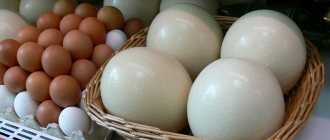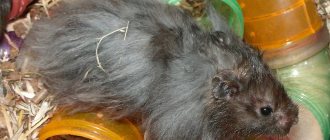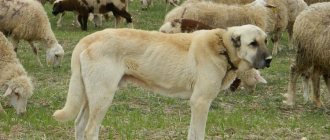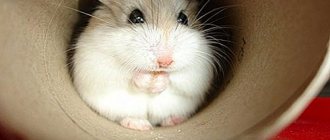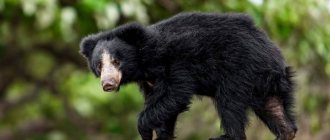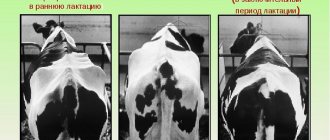How to weigh a hamster?
A hamster is a nimble animal that is difficult to keep in one place for a long time. If the pet is disobedient and untamed, you will have to cheat to find out the weight of the hamster. Use these short instructions to help you quickly measure your khoma without causing discomfort.
- Get your electronic scales ready. A regular kitchen scale will do. Their accuracy should be sufficient to weigh a light hamster.
- Take a container that matches the size of the animal. Without such an “accessory,” the animal can easily escape and it will not be possible to measure its “parameters.” The container will help contain the animal for at least a few minutes. You can use a regular glass or bowl. Before weighing, the tare weight should be reset to zero.
- To help your pet sit still, place a couple of sunflower seeds or another light treat in the container. This will interest the animal, and it will be calm for a while.
After you manage to measure the khoma, the result needs to be written down. This will help control weight loss or gain. Rapid weight loss indicates the presence of diseases. Weight control is also helpful when changing your diet or diet. This will ensure that your pet is eating new food and not hiding it in corners. A healthy hamster should weigh as much as is normal for an animal of its breed and age.
Article on the topic: The main differences and features of keeping a Somali cat
Dzungarian breed
Dzungarik is the most common inhabitant of apartments. This is a fluffy, cute pet that is fun to watch. The body shape of the jungarik is slightly different from its counterparts. The spine closer to the tail is slightly curved.
The animal is small in size, as a rule, no more than 10 cm. But the cheeks of the dwarf can grow significantly when “replenishing reserves”. While eating, hamsters are interesting and funny to watch. The size of the pet depends on the characteristics of its maintenance and nutrition. The Djungarian hamster weighs no more than 50 g.
Head, eyes, teeth and ears
The head is large, wide with a well-filled, blunt and relatively short muzzle, with developed jaws. The head profile is slightly curved (convex). The head is set tightly on the shoulders, with no visible neck.
The eyes of the Djungarian hamster are large, convex, rounded when viewed from the front, but slightly almond-shaped when viewed from the side, and set wide apart.
The ears are of medium size, larger than the eyes, set quite wide, vertical, rounded at the tips, without folds, when viewed from the side, the outer edge of the ear has a slight bend in the middle, the ears are not pressed to the body, clearly visible above the coat.
Minor deviations from the correct type. Slightly small eyes, slightly deep-set, slightly irregular in shape. The ears are slightly irregular in shape, small, flattened. Narrow and/or unfilled muzzle, narrow and long head, straight head profile. Slightly damaged ears.
Absence of an ear or ears, any damage to the eyes. Very strong deviations from type. Any deformities.
Syrian breed
The Syrian hamster is larger than the dwarf hamster. When choosing this breed, you should remember that the animal needs more space and food. The pet reaches 19 cm in length. The Syrian is sociable. This is a tame creature that requires a lot of attention and loves to be held. The weight of a Syrian varies between 100–200 grams.
Syrian Khomas have long or short hair and a variety of colors. It is recommended to keep animals in separate, spacious cages. Make sure your pet has enough space and food.
Reproduction
Hamsters form temporary mating pairs twice a year. Usually the male goes to the bride's burrow, where mating takes place. If a neighbor discovers a rival, a fierce battle ensues.
Pregnancy lasts approximately 21 days. Up to 10 babies can be born in a litter (less often 20). After 3 weeks, they can already feed themselves and leave their native land, settling in separate “apartments”. Family relationships are not supported in any way.
By the way, some researchers believe that the mother herself unceremoniously pushes the children out the door, preparing to accept the advances of the next groom.
Common hamster (wild)
The common hamster is a wild creature that is not kept at home. It is quite dangerous for humans, carries various diseases and is large in size. The size of an adult hamster is 30 cm. The creature has a weight appropriate for its size.
When choosing a pet, decide in advance on the breed of the animal. The size of the cage and equipment should be appropriate for the size of the hamster. Monitor your pet's weight to avoid health problems. A cheerful, playful Homa will delight you for a long time if you show appropriate attention and care.
Article on the topic: Where do hamsters live in the wild: habitat and enemies of the rodent
Care and maintenance at home
Proper care and comfortable conditions will ensure that the animal will always be active, friendly and cheerful.
Selecting a cage and filling it
The animal should be provided with sufficient freedom of movement. The cage must be at least 50x30 cm. A small space will lead to low physical activity, which can cause limb failure. You should not choose a high cage, because hamsters love to climb its walls. Falls from heights are very dangerous for a hamster.
Due to the high risk of injury, multi-story cages or complex staircase structures should be avoided.
Sawdust from fruit trees can be used as filler. Needles cannot be used because they cause allergies, lead to breathing problems and death.
You can buy corn litter at the pet store. It is considered the most convenient.
The cage can be filled with undyed paper napkins or towels, which should be torn into small pieces.
For a Djungarian hamster, it is necessary to install a wheel; its diameter should not be less than 16 cm. A small design will lead to curvature of the spine, which can cause limb failure.
You need to put a rest house in the cage. The animal will sleep in it during the day. It is not recommended to use houses with windows, because hamsters often get stuck in them.
Cotton wool, hay, fabric are hazardous materials. They must be kept away from the rodent.
Nutritional Features
Water for the animal is poured into a vacuum or ball drinker. The fluid should be changed daily. Bowls are not placed in the cage, as a wet animal may get sick.
The Djungarian hamster is prone to diabetes. For this reason, you should remove all sweet foods from your diet. The list of unsuitable foods includes carrots, apples, corn, raspberries, peach, pumpkin, etc. Potatoes, baked goods, onions, garlic, and citrus fruits should not be given.
The hamster's diet should consist of dry and wet food. It is recommended to purchase the first one ready-made at a pet store. It is better to use expensive feed, because... they are more balanced.
You can feed the animal with cucumber, lettuce, cauliflower or parsley. All leftover food must be removed immediately. To compensate for the lack of protein, the hamster should be given boiled chicken meat without spices. Outdoor insects should not be offered as they are infested with parasites.
How much does a hamster weigh
Even a non-professional breeder can breed wonderful fluffy hamsters. Before you become the owner of this little friend, you need to decide on the breed, since this determines how much the hamster weighs.
The parameters of a pet are very important, as they affect such nuances as:
- The size of the future home.
- Accessories for the cage, such as a wheel, mazes and more.
- Amount of feed consumed.
- The presence or absence of neighbors.
Djungarian hamsters
Djungarians are one of the most famous domestic animals, and have long rightfully won their place in the hearts of furry pet lovers. Thanks to their fascinating appearance and playful behavior, watching pets is quite interesting and curious.
The body shape of the dzhungarik has some differences in comparison with its closest relatives, since in the area of the tail its spine is slightly curved, which visually creates a small hump.
The body of a Djungarian hamster grows to a maximum of 10 cm, but generally the animal has a length of 6 to 9 cm. To understand how much a Djungarian hamster weighs, you need to take into account its size. This breed averages no more than 50 grams.
Taking into account the parameters of the animal, experts recommend purchasing a cage with dimensions of 30*50 cm, with frequent twigs. The diameter of the wheel should be about 13-17 cm.
Food
It feeds mainly on plant foods, but given the opportunity, it will not disdain insects and even small rodents, reptiles and amphibians. In spring and summer it eats leaves and roots of plants, but in winter it switches to a tuber-grain diet.
She mostly goes out hunting at dusk, at which time she stocks up on food for the winter. In the destroyed nests of the common hamster, phenomenal (up to 90 kg) reserves of selected grain were found: peas, wheat, barley, lentils, beans, which he collects from nearby agricultural lands all summer and autumn. On average, one hamster stores up to 10 kg of seeds and root crops for the winter.
Surprisingly, in the “warehouse” the seeds are arranged almost by variety, certainly by type.
At one time, a rodent can carry up to 70 g of grain in its cheek pouches! A loaded hamster can easily cover kilometer-long distances.
Syrian breed of hamsters
Owners should think in advance about how much a Syrian hamster weighs, since it is much larger than a dwarf hamster.
An adult furry pet can reach a size of about 19 cm and is a fairly large representative of its family. The animal loves to communicate with people and is willing to be held.
Such a pet weighs 100-200 grams. It is typical for this breed to have both long and short hair. Best for a hamster:
- Housing size 40*60 cm.
- Treadmill with a diameter of 18 cm.
- Living without neighbors.
Article on the topic: How long does a mosquito live - in total, after biting a person, without blood, in an apartment
Siberian breed of hamsters
The Siberian breed of hamster typically lives in the vast expanses of Siberia, where it can be found in its natural environment.
In appearance it is similar to the dzhungarika, and differs from them only in the color of its coat, which has a gray tint, and in winter it takes on a white color. This feature is interesting to study when animals live at home.
If owners are wondering how much a Djungarian hamster and its Siberian relative weigh, then the answer is quite simple. Since the weight of both of these representatives varies from 40 to 50 grams, Siberian hamsters grow to no more than 8 cm. For their maintenance, exactly the same conditions can be organized as for Djungarian hamsters.
Body structure
Hamsters look harmonious and proportional.
The structure of their body is characterized by the following features:
| Body type | Dense, knocked down |
| Body length (excluding tail) | 5–35 cm |
| Weight | 30–700 grams |
| Head | Not very large, round, on the muzzle there are hard whiskers (“whiskers”) of a dark color. |
| Ears | Small, rounded, on the outside the ears are covered with dark hairs, finer than the main fur. |
| Eyes | Little ones |
| Tail | Short, no more than 10 mm. It is thick at the base, then sharply tapers into a triangle shape. May be bare or covered with coarse and short hairs |
| Paws | Small but strong, with wide hands and feet. The toes have hard and strong claws, with the help of which the animal is able to dig holes even in very dense soils. Some species have bare limbs, others are covered with hair (this group is called “hair-footed”) |
| Wool | Thick and soft |
| Teeth | Sharp, strong. Teeth have no roots, but they grow throughout the rodent’s life. |
A distinctive feature of hamsters is the presence of special muscle cavities located in the lateral parts from the inner surface of the cheeks to the neck and very shoulders. These are the so-called cheek (or cheek) bags. For the rodent, they act as a kind of container into which the animal loads large supplies of food and then transfers them to the hole, where a stationary storage facility has already been installed, allowing the animal to be provided with food throughout the winter.
The presence of cheek pouches can make a hamster's life much easier. In addition to carrying food, the animal can use this feature of its physique for more original purposes, for example, swimming. The animal fills the volumetric cavity in the upper part of its body with air and thus receives an excellent “life preserver.”
Did you know? Cheek pouches are found not only in hamsters, but also in other rodents, including ground squirrels, chipmunks, harelips, pouched rats, and gophers. It is interesting that many species of monkeys have the same formations, but vultures, wolves and coyotes in the process of evolution have learned to use a safer place to transport food - their own stomach.
Dwarf hamsters
Most of all, owners prefer to purchase dwarf-sized hamsters. This is due to the low amount of hassle and ease of caring for the animal.
Dwarf breeds mean individuals weighing no more than 50 grams, with a height of about 5 cm.
For pets of this size, cages of 30*50 are suitable, and a water wheel can be taken with a diameter of about 13-15 cm.
Dwarf hamster breeds:
- Campbell's hamster.
- Taylor's hamster.
- Roborovsky's hamster, which is the smallest size.
Before choosing the most suitable pet for yourself and understanding how much a hamster should weigh, you need to consider several main features. However, regardless of the breed, keeping an animal at home will certainly bring joy and positive emotions to all residents of the house, the main thing is to pay attention to it and provide proper care.
Article on the topic: Hamster teeth: how many there are, why they turn yellow and fall out (photo)
Weight and size of hamsters of different breeds
Hamsters are wonderful animals that even a beginner can breed at home. Before you buy an animal, you need to know exactly the breed, because it depends on how much the hamster weighs. The weight and size of the pet are important. Based on the size of the pet, you should consider:
- the size of the cage you should buy;
- a set of pet entertainment (wheel, sticks) and their sizes;
- living together or living alone;
- amount of feed.
Djungarian hamster
This type of hamster has long taken root in modern apartments. His appearance is very pleasant, his behavior is funny, you can watch his actions for a long time.
The hamster differs in body shape from its relatives. On the back, closer to the tail, its spine is slightly curved, so it feels like the animal has a small hump.
It is very interesting to watch such an animal when it stuffs its cheek pouches; they are very large and can stretch well.
The size of the Djungarian hamster does not exceed 10 cm. Usually these animals grow up to 6-9 cm. Height and weight depend on the conditions of detention and individual characteristics. The weight of a Djungarian hamster can reach 50 grams.
djungarian hamster
Based on these data, experts advise buying a cage measuring 30x50 cm, with fine bars. The running wheel can be purchased with a diameter of 13-17 cm.
These hamsters can be kept alone.
Homeland of the Djungarians
Zoologist P. Pallas was the first to discover and describe the Djungarian hamster. This happened in 1773, when the scientist made an expedition through the territory corresponding to modern East Kazakhstan. At that time, the region was part of Dzungaria, or the Oirat Khanate.
The specific name of the animal has survived to this day. It reflects the historical name of the area where the hamster was encountered. The territory of Dzungaria in the modern sense is an area in northwestern China. Djungarians have never lived here. Their real homeland is the steppes in eastern Kazakhstan.
Sounds that the Djungarian hamster makes:
Syrian hamster
If future owners have chosen the Syrian breed, they need to know how much a Syrian hamster weighs, because this species is very different in size from the Djungarian. The size of an adult Syrian hamster can reach 19 cm, which is quite a large animal.
Despite its size, this hamster loves to be held, loves to attract attention and enjoys any communication.
Article on the topic: Is it possible to keep a dwarf and a Syrian hamster alone; will two hamsters get along together?
The weight of the Syrian hamster ranges from 100 to 200 grams.
Syrian hamster
It is interesting that pets of this breed can be either short-haired or long-haired.
- cage 40x60 cm;
- running wheel, diameter 18 cm;
- Single accommodation.
Siberian hamster
The Siberian hamster can be found in nature; it lives in Siberia, hence its name.
They are very reminiscent of Djungarian hamsters, differing only in the color of their fur. The Siberian has a gray color, and in winter the animal’s coat becomes completely white. This is especially interesting to observe when kept at home.
The average weight of a pet reaches 40-50 grams, and these animals grow no more than 8 cm in size. To keep a Siberian hamster, a cage the same as that of a Djungarian pet is suitable.
siberian hamster
Common hamster (wild)
The weight of the common hamster is greater than all other breeds. Because of its size, it is not a frequent guest in homes; it is more convenient to keep small hamsters.
The body length of an ordinary hamster reaches 30 cm. It is a tailed animal, and the tail is quite long, from 5 to 8 cm.
common hamster
This hamster is a big fan of “home comfort”; its burrows consist of many corridors, storage rooms and exits. Sometimes in the storerooms of such a hard worker you can find reserves of up to 15 kg.
Lifestyle
It lives underground, making a deep (up to two meters) and long (up to 8 meters) burrow. Such a dwelling has its own storage room, several nests for rest, up to five, less often ten entrances and exits. In rare cases, a gopher or other burrowing animal may take over the house.
The floor in the hole is lined with straw. Each “door” has its own function:
- Usually a gentle descent into a hole is the way out.
- The more vertical hole is the entrance, through which the animal returns home; it especially likes to use it in times of danger.
- The third tunnel leads to the “storage room”.
During the winter, the hamster plugs all the holes with earth.
The animal is very clean, its house is a standard of cleanliness, it never “soils” in the living area, and especially in the storage area, and uses special latrines for this.
The common hamster is a loner and forms temporary pairs only during the mating season.
In everyday life he is aggressive and pugnacious. If there is a mortal threat, it can even rush at a person.
The animal has a terrifying appearance: it stands on its hind legs, snaps its teeth and moves to attack.
Natural predators for the rodent are foxes, ferrets, stoats, eagles, owls, and eagle owls.


